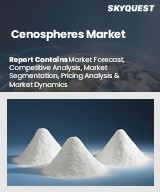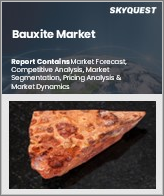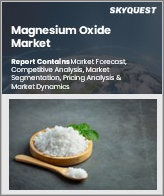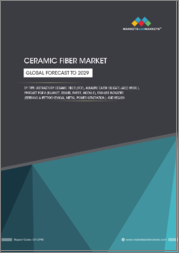
|
시장보고서
상품코드
1601268
세계의 내화물 시장 : 알칼리도, 물리적 형상, 제조 공정, 제품, 용도별 예측(2025-2030년)Refractories Market by Alkalinity (Acidic & Neutral Refractories, Basic Refractories), Physical Form (Shaped Refractories, Unshaped Refractories), Manufacturing Process, Product, Application - Global Forecast 2025-2030 |
||||||
내화물 시장은 2023년에 357억 7,000만 달러로 평가되었고, 2024년에는 377억 3,000만 달러에 도달할 것으로 예측되며, CAGR 5.62%로 성장하고, 2030년에는 524억 6,000만 달러에 달할 것으로 예상됩니다.
내화물은 주로 고온로, 반응로 및 기타 처리 장치의 내장에 사용되는 내열 재료입니다. 세라믹과 광물을 주성분으로 삼아 철강, 유리, 시멘트, 비철금속 제조 등 산업에서 중요한 역할을 하고 있습니다. 내화물의 필요성은 극단적 인 온도, 화학적 공격 및 기계적 스트레스를 견딜 수있는 능력으로 인해 산업 설비의 수명과 효율성을 보장합니다. 그 용도는 광범위하고, 킬른, 소각로, 반응로의 라이닝을 비롯해, 용융 재료의 처리와 봉쇄를 실시하는 야금 섹터에서 특히 주목받고 있습니다.
| 주요 시장 통계 | |
|---|---|
| 기준년(2023) | 357억 7,000만 달러 |
| 추정년(2024) | 377억 3,000만 달러 |
| 예측년(2030) | 524억 6,000만 달러 |
| CAGR(%) | 5.62% |
내화물 시장 성장은 철강 생산의 세계 왕성한 수요, 고성능 내화물의 진보, 에너지 효율적인 솔루션에 대한 의식 증가 등 요인의 영향을 받고 있습니다. 이것은 철강과 시멘트 수요를 증가시키고 시장을 더욱 견인합니다. 현재의 비즈니스 기회는 이산화탄소 배출량이 적은 환경 친화적 인 내화물 개발과 환경 규제를 준수하기 위해 재활용률을 향상시키는 데 있습니다. R&D 투자도 큰 이익을 가져올 수 있습니다.
그 중요한 역할에도 불구하고, 시장은 원재료 비용의 변화, 엄격한 환경 규제, 대체 재료와의 경쟁 등의 과제에 직면하고 있습니다. 제조 공정 개발, 열효율 향상, 지속가능성을 위한 폐기물 관리 전략의 도입에 초점을 맞추어야 합니다.
사업의 성장을 가속하기 위해 나노기술에 의한 경량화 내화물과 보강재의 가능성을 탐구하면 경쟁 우위를 가져올 수 있습니다. 기술 집약적이며 진화하는 산업과 규제의 요구에 부응하기 위해 지속적으로 혁신이 필요합니다.
시장 역학: 빠르게 진화하는 내화물 시장의 주요 시장 인사이트 공개
내화물 시장은 수요 및 공급의 역동적인 상호작용에 의해 변모를 이루고 있습니다. 비즈니스 기회를 얻을 수 있습니다. 이러한 동향을 종합적으로 파악함으로써 기업은 정치적, 지리적, 기술적, 사회적, 경제적 영역에 걸친 다양한 리스크를 경감할 수 있음과 동시에 소비자 행동과 그것이 제조 비용과 구매 동향에 미치는 영향을보다 명확하게 이해할 수 있습니다.
- 시장 성장 촉진요인
- 세계 제조업의 지속적인 확대
- 정부 투자로 인프라 정비 활동 확대
- 시장 성장 억제요인
- 원재료 가용성 제한 및 가격 변동
- 시장 기회
- 내화물의 재활용에 관한 연구 개발 증가
- 내화물의 커스터마이즈 가능성
- 시장의 과제
- 내화물의 사용과 제조에 관한 정부의 엄격한 규제
Porter's Five Forces: 내화물 시장을 탐색하는 전략 도구
Portre's Five Forces 프레임워크는 내화물 시장 경쟁 구도를 이해하는 중요한 도구입니다. 기업이 시장 내 세력도를 평가하고 신규 사업의 수익성을 판단하는 데 도움이 됩니다. 당신은 더 강인한 시장에서 포지셔닝을 보장할 수 있습니다.
PESTLE 분석 : 내화물 시장에서 외부로부터의 영향 파악
외부 거시 환경 요인은 내화물 시장의 성과 역학을 형성하는 데 매우 중요한 역할을합니다. PESTLE 요인을 조사함으로써 기업은 잠재적인 위험과 기회를 더 잘 이해할 수 있습니다. 적극적인 의사 결정을 할 준비가되어 있습니다.
시장 점유율 분석 : 내화물 시장 경쟁 구도 파악
내화물 시장의 상세한 시장 점유율 분석을 통해 공급업체의 성과를 종합적으로 평가할 수 있습니다. 분명히 이 분석을 통해 시장 집중, 단편화, 통합 동향을 밝혀내고 벤더는 경쟁이 치열해지는 가운데 자사의 지위를 높이는 전략적 의사결정을 하기 위해 필요한 지견을 얻을 수 있습니다.
FPNV 포지셔닝 매트릭스 : 내화물 시장에서 공급업체의 성능 평가
FPNV 포지셔닝 매트릭스는 내화물 시장에서 벤더를 평가하는 중요한 도구입니다. 네 가지 사분면은 공급업체를 명확하고 정확하게 구분하여 사용자가 전략 목표에 가장 적합한 파트너 및 솔루션을 식별하는 데 도움이 됩니다.
이 보고서는 주요 관심 분야를 포괄하는 종합적인 시장 분석을 제공합니다.
1. 시장 침투: 업계 주요 기업의 광범위한 데이터를 포함한 현재 시장 환경의 상세한 검토.
2. 시장 개척도: 신흥 시장의 성장 기회를 파악하고 기존 분야의 확장 가능성을 평가하며 미래 성장을 위한 전략적 로드맵을 제공합니다.
3. 시장 다양화: 최근 제품 출시, 미개척 지역, 업계의 주요 진보, 시장을 형성하는 전략적 투자를 분석합니다.
4. 경쟁 평가 및 정보 : 경쟁 구도를 철저히 분석하여 시장 점유율, 사업 전략, 제품 포트폴리오, 인증, 규제 당국 승인, 특허 동향, 주요 기업의 기술 진보 등을 검증합니다.
5. 제품 개발 및 혁신 : 미래 시장 성장을 가속할 것으로 예상되는 최첨단 기술, R&D 활동, 제품 혁신을 강조합니다.
또한 이해관계자가 충분한 정보를 얻고 의사결정을 할 수 있도록 중요한 질문에 대답하고 있습니다.
1. 현재 시장 규모와 향후 성장 예측은?
2. 최고의 투자 기회를 제공하는 제품, 부문 및 지역은 어디입니까?
3. 시장을 형성하는 주요 기술 동향과 규제의 영향은?
4. 주요 벤더의 시장 점유율과 경쟁 포지션은?
5. 벤더 시장 진입·철수 전략의 원동력이 되는 수익원과 전략적 기회는 무엇인가?
목차
제1장 서문
제2장 조사 방법
제3장 주요 요약
제4장 시장 개요
제5장 시장 인사이트
- 시장 역학
- 성장 촉진요인
- 제조업의 세계적 확대
- 정부 투자로 인프라 정비 활동 확대
- 억제요인
- 원재료 입수 제한 및 가격 변동
- 기회
- 내화물 재활용을 위한 연구개발 활동 강화
- 주문을 받아서 만들어진 내화물에 새로운 가능성
- 과제
- 내화물의 사용과 제조에 관한 정부에 의한 엄격한 규제
- 성장 촉진요인
- 시장 세분화 분석
- 알칼리도: 제철 공정에서 염기성 내화물의 사용 증가
- 물리적 형상: 형상이 없는 내화물에 비해 정밀도와 내구성이 뛰어나기 때문에 형상이 있는 내화물 수요가 높아지고 있습니다.
- 제조 공정: 내화물 생산에 있어서의 성형 제조 공정의 이용 증가
- 응용: 야금 공정에서 내화물의 지수적 중요성
- Porter's Five Forces 분석
- PESTEL 분석
- 정치적
- 경제
- 사교
- 기술적
- 법률상
- 환경
제6장 내화물 시장 : 알칼리도별
- 산성과 중성 내화물
- 알루미나 내화물
- 카본 내화물
- 크로마이트 내화물
- 파이어 클레이 내화물
- 실리카 내화물
- 지르코니아 내화물
- 기본 내화물
- 백운석 내화물
- 마그네사이트 내화물
제7장 내화물 시장 : 물리적 형상별
- 형태가 있는 내화물
- 형태가 없는 내화물
제8장 내화물 시장 : 제조 공정별
- 드라이 프레스 프로세스
- 형성
- 퓨즈드 캐스트
- 수작업 성형
- 미형성
제9장 내화물 시장 : 제품별
- 캐스터블 및 모르타르
- 세라믹 섬유와 내화 벽돌
- 흑연 블록
- 단열 내화 벽돌
제10장 내화물 시장 : 용도별
- 유리 탱크
- 석회·시멘트 가마
- 야금용 버너와 퍼니스
- 재생장치
- 스토브
제11장 아메리카의 내화물 시장
- 아르헨티나
- 브라질
- 캐나다
- 멕시코
- 미국
제12장 아시아태평양 내화물시장
- 호주
- 중국
- 인도
- 인도네시아
- 일본
- 말레이시아
- 필리핀
- 싱가포르
- 한국
- 대만
- 태국
- 베트남
제13장 유럽·중동 및 아프리카의 내화물 시장
- 덴마크
- 이집트
- 핀란드
- 프랑스
- 독일
- 이스라엘
- 이탈리아
- 네덜란드
- 나이지리아
- 노르웨이
- 폴란드
- 카타르
- 러시아
- 사우디아라비아
- 남아프리카
- 스페인
- 스웨덴
- 스위스
- 터키
- 아랍에미리트(UAE)
- 영국
제14장 경쟁 구도
- 시장 점유율 분석, 2023년
- FPNV 포지셔닝 매트릭스, 2023년
- 경쟁 시나리오 분석
- Hoganas Borgestad AB가 스웨덴의 뷔브에 환경효율이 높은 내화물 공장 개설: 지속 가능한 생산과 혁신을 위한 전략적 움직임
- IFGL에 의한 싱글 피스 프리캐스트 EAF 델타루프의 발매 내화물
- IFGL 내화물이 두르가풀에 새로운 선진적인 창고를 오픈
- Materials Processing Institute(MPI)가 Trent 내화물 및 Kanthal과의 3년간의 수소 조사 계약을 발표
- RHI Magnesita가 Seven의 획기적인 인수를 발표 내화물
- RHI Magnesita, 제조 능력 확대를 위해 인도에 3600캐롤 루피를 투자한다고 발표
- Vesuvius Group, 인도 내 내화물 생산 능력 증강에 6,100만 달러를 투자 예정
- 탈탄소화를 목표로 하는 협력 협정 내화물
- HarbisonWalker International(HWI), Platinum Equity에 의한 인수를 발표, 내화물 산업의 지속 가능한 성장을 실현
- Raghav Productivity Enhancers와 Capital Refractories이 제휴해, 국제 시장에서 실리카 래밍 매스를 판매
- Sisecam, 내화물 제조업체 Refel SpA 인수 발표
기업 목록
- AGC Inc.
- Allied Mineral Products, LLC
- Almatis BV
- Alteo
- AluChem, Inc.
- ArcelorMittal SA
- Chosun Refractories Co., Ltd.
- CoorsTek, Inc.
- Delta Refractories, Inc.
- Future Refractories
- Galaxy Enterprises
- HarbisonWalker International, Inc.
- Hoganas Borgestad Holding AB
- IFGL Refractories Limited
- Imerys SA
- Intocast AG
- Krosaki Harima Corporation
- Kyanite Mining Corporation
- KYOCERA Corporation
- Kumas Manyezit Sanayi AS
- Lhoist Group
- Magnezit Group
- Morgan Advanced Materials PLC
- PPG Industries, Inc.
- Refmon Industries
- Resco Products, Inc.
- RHI Magnesita GmbH
- Ruitai Materials Technology Co.,Ltd.
- Saint-Gobain SA
- The Refratechnik Group
- Trent Refractories Ltd.
- United Refractories Co.
- Vesuvius PLC
- Sisecam
The Refractories Market was valued at USD 35.77 billion in 2023, expected to reach USD 37.73 billion in 2024, and is projected to grow at a CAGR of 5.62%, to USD 52.46 billion by 2030.
Refractories are heat-resistant materials used primarily to line high-temperature furnaces, reactors, and other processing units. They are fundamentally composed of ceramics and minerals and are key to processes in industries such as steel, glass, cement, and non-ferrous metal manufacturing. The necessity of refractories arises from their ability to withstand extreme temperatures, chemical attack, and mechanical stress, thus ensuring the longevity and efficiency of industrial equipment. Their applications are extensive, covering the lining of kilns, incinerators, and reactors across industries, with particular prominence in the metallurgical sector where they aid in the processing and containment of molten materials.
| KEY MARKET STATISTICS | |
|---|---|
| Base Year [2023] | USD 35.77 billion |
| Estimated Year [2024] | USD 37.73 billion |
| Forecast Year [2030] | USD 52.46 billion |
| CAGR (%) | 5.62% |
Market growth for refractories is being influenced by factors such as the robust global demand in steel production, advancements in high-performance refractory materials, and increasing awareness of energy-efficient solutions. Emerging economies are expanding their infrastructure, and this augments the demand for steel and cement, further driving the market. Current opportunities lie in developing eco-friendly refractories with a lower carbon footprint and improving recycling rates to comply with environmental regulations. Investment in R&D for developing advanced materials with enhanced durability and performance could also yield strong returns.
Despite their critical role, the market faces challenges, including raw material cost fluctuations, stringent environmental regulations, and competition from alternative materials. The high cost and complexity of manufacturing advanced refractories pose additional limitations. Innovation should focus on developing cost-effective manufacturing processes, enhancing thermal efficiency, and incorporating waste management strategies for sustainability. Key opportunities also lie in digital solutions, such as monitoring systems for predictive maintenance to optimize the lifespan of refractory linings.
To foster business growth, exploring the potential of lightweight refractories and reinforcing materials with nanotechnology could offer competitive advantages. The nature of this market is highly specialized and technology-intensive, with a continual need for innovation to meet evolving industrial and regulatory demands.
Market Dynamics: Unveiling Key Market Insights in the Rapidly Evolving Refractories Market
The Refractories Market is undergoing transformative changes driven by a dynamic interplay of supply and demand factors. Understanding these evolving market dynamics prepares business organizations to make informed investment decisions, refine strategic decisions, and seize new opportunities. By gaining a comprehensive view of these trends, business organizations can mitigate various risks across political, geographic, technical, social, and economic domains while also gaining a clearer understanding of consumer behavior and its impact on manufacturing costs and purchasing trends.
- Market Drivers
- Continuous expansion of the manufacturing industries globally
- Growing infrastructure development activities with government investment
- Market Restraints
- Limited availability and volatility in prices of raw materials
- Market Opportunities
- Increasing research & development activities for recycling of refractories
- Emerging potential toward customized refractories
- Market Challenges
- Stringent regulations by the government for the usage and manufacturing of refractories
Porter's Five Forces: A Strategic Tool for Navigating the Refractories Market
Porter's five forces framework is a critical tool for understanding the competitive landscape of the Refractories Market. It offers business organizations with a clear methodology for evaluating their competitive positioning and exploring strategic opportunities. This framework helps businesses assess the power dynamics within the market and determine the profitability of new ventures. With these insights, business organizations can leverage their strengths, address weaknesses, and avoid potential challenges, ensuring a more resilient market positioning.
PESTLE Analysis: Navigating External Influences in the Refractories Market
External macro-environmental factors play a pivotal role in shaping the performance dynamics of the Refractories Market. Political, Economic, Social, Technological, Legal, and Environmental factors analysis provides the necessary information to navigate these influences. By examining PESTLE factors, businesses can better understand potential risks and opportunities. This analysis enables business organizations to anticipate changes in regulations, consumer preferences, and economic trends, ensuring they are prepared to make proactive, forward-thinking decisions.
Market Share Analysis: Understanding the Competitive Landscape in the Refractories Market
A detailed market share analysis in the Refractories Market provides a comprehensive assessment of vendors' performance. Companies can identify their competitive positioning by comparing key metrics, including revenue, customer base, and growth rates. This analysis highlights market concentration, fragmentation, and trends in consolidation, offering vendors the insights required to make strategic decisions that enhance their position in an increasingly competitive landscape.
FPNV Positioning Matrix: Evaluating Vendors' Performance in the Refractories Market
The Forefront, Pathfinder, Niche, Vital (FPNV) Positioning Matrix is a critical tool for evaluating vendors within the Refractories Market. This matrix enables business organizations to make well-informed decisions that align with their goals by assessing vendors based on their business strategy and product satisfaction. The four quadrants provide a clear and precise segmentation of vendors, helping users identify the right partners and solutions that best fit their strategic objectives.
Key Company Profiles
The report delves into recent significant developments in the Refractories Market, highlighting leading vendors and their innovative profiles. These include AGC Inc., Allied Mineral Products, LLC, Almatis B.V., Alteo, AluChem, Inc., ArcelorMittal S.A., Chosun Refractories Co., Ltd., CoorsTek, Inc., Delta Refractories, Inc., Future Refractories, Galaxy Enterprises, HarbisonWalker International, Inc., Hoganas Borgestad Holding AB, IFGL Refractories Limited, Imerys SA, Intocast AG, Krosaki Harima Corporation, Kyanite Mining Corporation, KYOCERA Corporation, Kumas Manyezit Sanayi A.S., Lhoist Group, Magnezit Group, Morgan Advanced Materials PLC, PPG Industries, Inc., Refmon Industries, Resco Products, Inc., RHI Magnesita GmbH, Ruitai Materials Technology Co.,Ltd., Saint-Gobain S.A., The Refratechnik Group, Trent Refractories Ltd., United Refractories Co., Vesuvius PLC, and Sisecam.
Market Segmentation & Coverage
This research report categorizes the Refractories Market to forecast the revenues and analyze trends in each of the following sub-markets:
- Based on Alkalinity, market is studied across Acidic & Neutral Refractories and Basic Refractories. The Acidic & Neutral Refractories is further studied across Alumina Refractories, Carbon Refractories, Chromite Refractories, Fireclay Refractories, Silica Refractories, and Zirconia Refractories. The Basic Refractories is further studied across Dolomite Refractories and Magnesite Refractories.
- Based on Physical Form, market is studied across Shaped Refractories and Unshaped Refractories.
- Based on Manufacturing Process, market is studied across Dry Press Process, Formed, Fused Cast, Hand Molded, and Unformed.
- Based on Product, market is studied across Castables & Mortars, Ceramic Fibers & Firebricks, Graphite Blocks, and Insulation Fire Brick.
- Based on Application, market is studied across Glass Tanks, Lime & Cement Kilns, Metallurgical Burners & Furnaces, Regenerators, and Stoves.
- Based on Region, market is studied across Americas, Asia-Pacific, and Europe, Middle East & Africa. The Americas is further studied across Argentina, Brazil, Canada, Mexico, and United States. The United States is further studied across Alaska, Arizona, California, Georgia, Michigan, Missouri, Montana, Nevada, North Dakota, West Virginia, and Wyoming. The Asia-Pacific is further studied across Australia, China, India, Indonesia, Japan, Malaysia, Philippines, Singapore, South Korea, Taiwan, Thailand, and Vietnam. The Europe, Middle East & Africa is further studied across Denmark, Egypt, Finland, France, Germany, Israel, Italy, Netherlands, Nigeria, Norway, Poland, Qatar, Russia, Saudi Arabia, South Africa, Spain, Sweden, Switzerland, Turkey, United Arab Emirates, and United Kingdom.
The report offers a comprehensive analysis of the market, covering key focus areas:
1. Market Penetration: A detailed review of the current market environment, including extensive data from top industry players, evaluating their market reach and overall influence.
2. Market Development: Identifies growth opportunities in emerging markets and assesses expansion potential in established sectors, providing a strategic roadmap for future growth.
3. Market Diversification: Analyzes recent product launches, untapped geographic regions, major industry advancements, and strategic investments reshaping the market.
4. Competitive Assessment & Intelligence: Provides a thorough analysis of the competitive landscape, examining market share, business strategies, product portfolios, certifications, regulatory approvals, patent trends, and technological advancements of key players.
5. Product Development & Innovation: Highlights cutting-edge technologies, R&D activities, and product innovations expected to drive future market growth.
The report also answers critical questions to aid stakeholders in making informed decisions:
1. What is the current market size, and what is the forecasted growth?
2. Which products, segments, and regions offer the best investment opportunities?
3. What are the key technology trends and regulatory influences shaping the market?
4. How do leading vendors rank in terms of market share and competitive positioning?
5. What revenue sources and strategic opportunities drive vendors' market entry or exit strategies?
Table of Contents
1. Preface
- 1.1. Objectives of the Study
- 1.2. Market Segmentation & Coverage
- 1.3. Years Considered for the Study
- 1.4. Currency & Pricing
- 1.5. Language
- 1.6. Stakeholders
2. Research Methodology
- 2.1. Define: Research Objective
- 2.2. Determine: Research Design
- 2.3. Prepare: Research Instrument
- 2.4. Collect: Data Source
- 2.5. Analyze: Data Interpretation
- 2.6. Formulate: Data Verification
- 2.7. Publish: Research Report
- 2.8. Repeat: Report Update
3. Executive Summary
4. Market Overview
5. Market Insights
- 5.1. Market Dynamics
- 5.1.1. Drivers
- 5.1.1.1. Continuous expansion of the manufacturing industries globally
- 5.1.1.2. Growing infrastructure development activities with government investment
- 5.1.2. Restraints
- 5.1.2.1. Limited availability and volatility in prices of raw materials
- 5.1.3. Opportunities
- 5.1.3.1. Increasing research & development activities for recycling of refractories
- 5.1.3.2. Emerging potential toward customized refractories
- 5.1.4. Challenges
- 5.1.4.1. Stringent regulations by the government for the usage and manufacturing of refractories
- 5.1.1. Drivers
- 5.2. Market Segmentation Analysis
- 5.2.1. Alkalinity: Rising use of basic refractories in the steel-making process
- 5.2.2. Physical Form: Increasing demand for shaped refractories as they offer greater precision and durability compared to unshaped refractories
- 5.2.3. Manufacturing Process: Growing use of formed manufacturing process in the refractory production
- 5.2.4. Application: Exponential importance of refractories in metallurgical processes
- 5.3. Porter's Five Forces Analysis
- 5.3.1. Threat of New Entrants
- 5.3.2. Threat of Substitutes
- 5.3.3. Bargaining Power of Customers
- 5.3.4. Bargaining Power of Suppliers
- 5.3.5. Industry Rivalry
- 5.4. PESTLE Analysis
- 5.4.1. Political
- 5.4.2. Economic
- 5.4.3. Social
- 5.4.4. Technological
- 5.4.5. Legal
- 5.4.6. Environmental
6. Refractories Market, by Alkalinity
- 6.1. Introduction
- 6.2. Acidic & Neutral Refractories
- 6.2.1. Alumina Refractories
- 6.2.2. Carbon Refractories
- 6.2.3. Chromite Refractories
- 6.2.4. Fireclay Refractories
- 6.2.5. Silica Refractories
- 6.2.6. Zirconia Refractories
- 6.3. Basic Refractories
- 6.3.1. Dolomite Refractories
- 6.3.2. Magnesite Refractories
7. Refractories Market, by Physical Form
- 7.1. Introduction
- 7.2. Shaped Refractories
- 7.3. Unshaped Refractories
8. Refractories Market, by Manufacturing Process
- 8.1. Introduction
- 8.2. Dry Press Process
- 8.3. Formed
- 8.4. Fused Cast
- 8.5. Hand Molded
- 8.6. Unformed
9. Refractories Market, by Product
- 9.1. Introduction
- 9.2. Castables & Mortars
- 9.3. Ceramic Fibers & Firebricks
- 9.4. Graphite Blocks
- 9.5. Insulation Fire Brick
10. Refractories Market, by Application
- 10.1. Introduction
- 10.2. Glass Tanks
- 10.3. Lime & Cement Kilns
- 10.4. Metallurgical Burners & Furnaces
- 10.5. Regenerators
- 10.6. Stoves
11. Americas Refractories Market
- 11.1. Introduction
- 11.2. Argentina
- 11.3. Brazil
- 11.4. Canada
- 11.5. Mexico
- 11.6. United States
12. Asia-Pacific Refractories Market
- 12.1. Introduction
- 12.2. Australia
- 12.3. China
- 12.4. India
- 12.5. Indonesia
- 12.6. Japan
- 12.7. Malaysia
- 12.8. Philippines
- 12.9. Singapore
- 12.10. South Korea
- 12.11. Taiwan
- 12.12. Thailand
- 12.13. Vietnam
13. Europe, Middle East & Africa Refractories Market
- 13.1. Introduction
- 13.2. Denmark
- 13.3. Egypt
- 13.4. Finland
- 13.5. France
- 13.6. Germany
- 13.7. Israel
- 13.8. Italy
- 13.9. Netherlands
- 13.10. Nigeria
- 13.11. Norway
- 13.12. Poland
- 13.13. Qatar
- 13.14. Russia
- 13.15. Saudi Arabia
- 13.16. South Africa
- 13.17. Spain
- 13.18. Sweden
- 13.19. Switzerland
- 13.20. Turkey
- 13.21. United Arab Emirates
- 13.22. United Kingdom
14. Competitive Landscape
- 14.1. Market Share Analysis, 2023
- 14.2. FPNV Positioning Matrix, 2023
- 14.3. Competitive Scenario Analysis
- 14.3.1. Hoganas Borgestad AB Launches Eco-Efficient Refractory Plant In Bjuv, Sweden: A Strategic Move Toward Sustainable Production And Innovation
- 14.3.2. Launch of the Single-Piece Precast EAF Delta Roof by IFGL Refractories
- 14.3.3. IFGL Refractories Launches New and Advanced Warehouse in Durgapur
- 14.3.4. Materials Processing Institute (MPI) Unveils Three Year Hydrogen Research Agreement with Trent Refractories & Kanthal
- 14.3.5. RHI Magnesita Unveils Revolutionary Acquisition of Seven Refractories
- 14.3.6. RHI Magnesita Annonced Investing INR 3600 Crore in India to Expand Manufacturing Capabilities
- 14.3.7. Vesuvius Group Expected to Invest USD 61 Million to Elevate Refractory Production Capacities in India
- 14.3.8. Cooperation Agreement Aims to Decarbonize Refractories
- 14.3.9. HarbisonWalker International (HWI) Announcement on Acquisition by Platinum Equity for Introducing Sustainable Refractory Industry Growth
- 14.3.10. Raghav Productivity Enhancers and Capital Refractories Partners to Distribute Silica Ramming Mass In International Markets
- 14.3.11. Sisecam Announces Acquisition of Refractory Manufacturer Refel S.p.A.
Companies Mentioned
- 1. AGC Inc.
- 2. Allied Mineral Products, LLC
- 3. Almatis B.V.
- 4. Alteo
- 5. AluChem, Inc.
- 6. ArcelorMittal S.A.
- 7. Chosun Refractories Co., Ltd.
- 8. CoorsTek, Inc.
- 9. Delta Refractories, Inc.
- 10. Future Refractories
- 11. Galaxy Enterprises
- 12. HarbisonWalker International, Inc.
- 13. Hoganas Borgestad Holding AB
- 14. IFGL Refractories Limited
- 15. Imerys SA
- 16. Intocast AG
- 17. Krosaki Harima Corporation
- 18. Kyanite Mining Corporation
- 19. KYOCERA Corporation
- 20. Kumas Manyezit Sanayi A.S.
- 21. Lhoist Group
- 22. Magnezit Group
- 23. Morgan Advanced Materials PLC
- 24. PPG Industries, Inc.
- 25. Refmon Industries
- 26. Resco Products, Inc.
- 27. RHI Magnesita GmbH
- 28. Ruitai Materials Technology Co.,Ltd.
- 29. Saint-Gobain S.A.
- 30. The Refratechnik Group
- 31. Trent Refractories Ltd.
- 32. United Refractories Co.
- 33. Vesuvius PLC
- 34. Sisecam



















